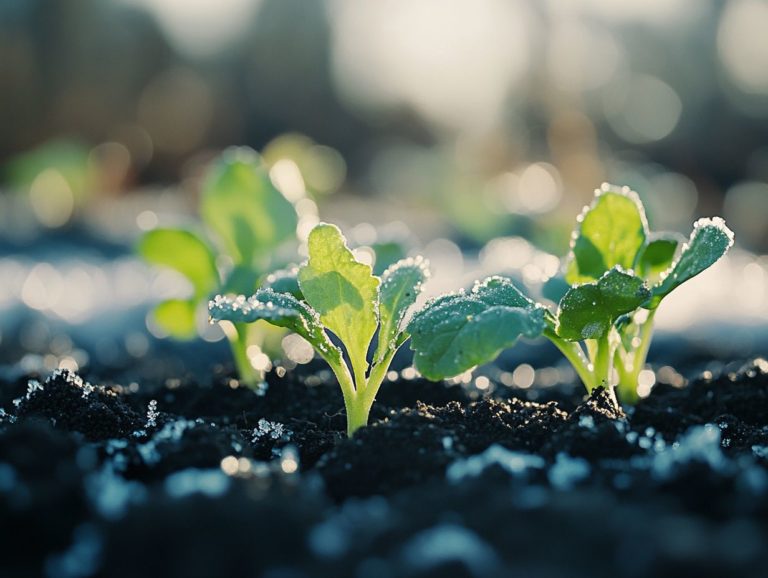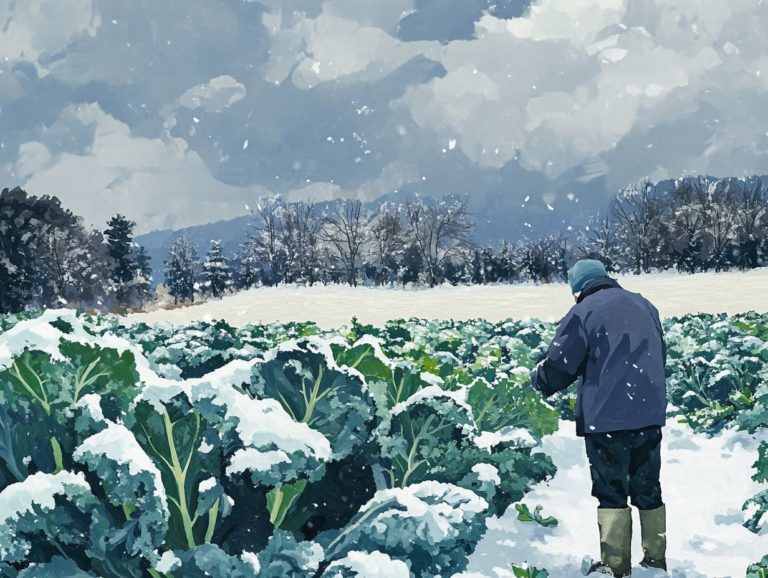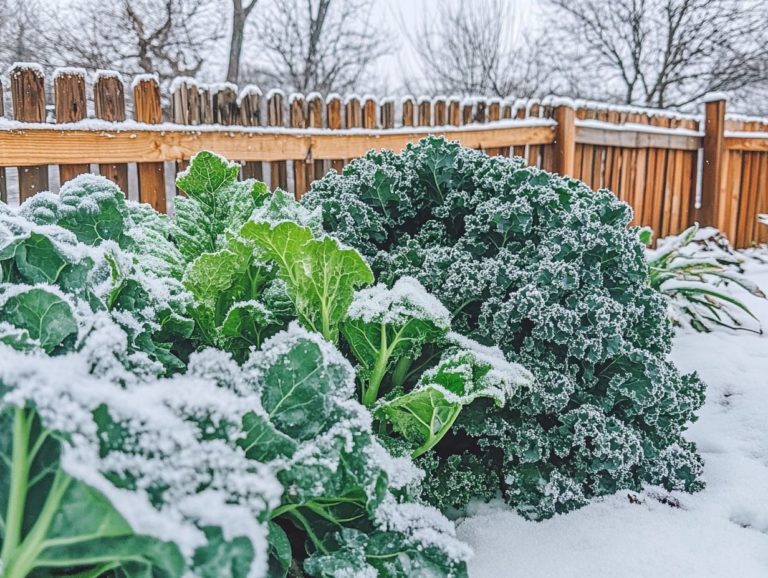Understanding Frost Dates in Your Area
Frost dates hold immense significance for both gardeners and farmers, defining the important limits of growing seasons.
Understanding when the last frost of spring and the first frost of fall occur can profoundly impact your ability to protect your plants and maximize your yields. This article delves into the definition and importance of frost dates, examining the various factors that influence them, and offering practical methods for determining local frost dates.
You’ll discover valuable tips for preparing your plants and extending the growing season. This ensures that your garden not only survives but thrives, even in the face of the chill!
Contents
- Key Takeaways:
- What are Frost Dates?
- Factors Affecting Frost Dates
- How to Determine Your Frost Dates
- Preparing for Frost
- Extending the Growing Season
- Frequently Asked Questions
- What are frost dates and why are they important?
- How do I find out the frost dates in my area?
- Why do frost dates vary from year to year?
- What happens if I plant too early or too late based on the frost dates?
- Can I extend my growing season beyond the frost dates?
- Do frost dates apply to all types of plants?
Key Takeaways:
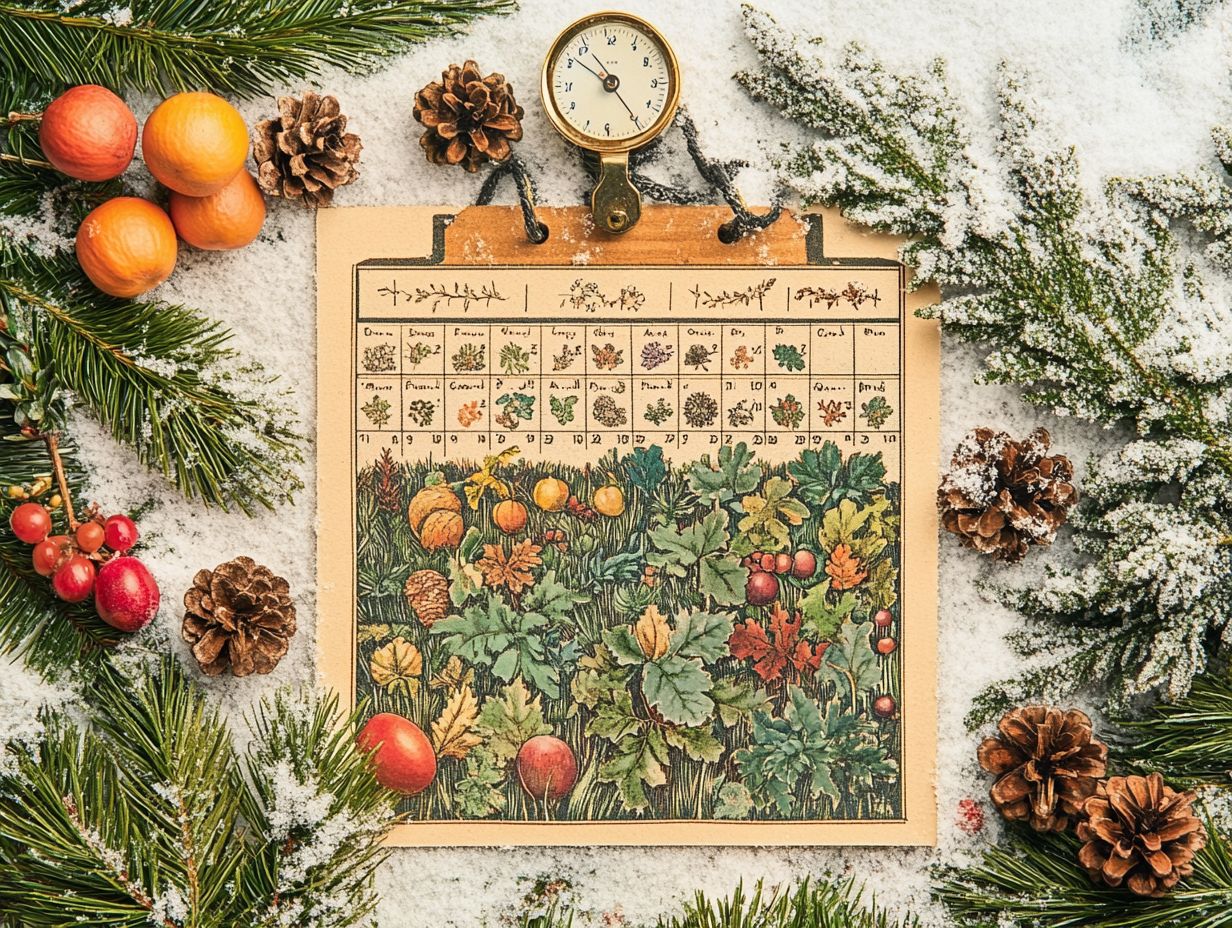
- Frost dates are the average dates of the first and last frost in a specific area. Understanding these dates is crucial for successful gardening and farming. Check local frost dates online to plan your planting schedule.
- Climate, elevation, and geography are key factors that affect frost dates. These elements impact the temperature and length of the growing season in a particular region. Be mindful of your local climate when planning your garden.
- There are various methods to determine your local frost dates, including historical data, online resources, and talking to experienced gardeners. Knowing your frost dates can help you plan and prepare for the cold weather. Use these resources to gather the necessary information.
What are Frost Dates?
Frost dates serve as essential markers in your gardening journey, indicating the last frost of spring and the first frost of fall. These dates significantly impact your gardening practices and crop yields.
By grasping the significance of frost dates, you can refine your planting schedule and safeguard vulnerable plants. This enhances your chances for a bountiful vegetable harvest.
In North America, frost dates fluctuate considerably across zones defined by the U.S. Department of Agriculture, which indicate the average temperature range. Knowing your specific area’s frost dates empowers you to avoid frost damage and make the most of your gardening endeavors.
Definition and Importance
Frost dates refer to those critical days when temperatures are expected to dip to freezing, resulting in ice crystals that can harm tender, frost-sensitive plants.
Understanding these dates is crucial for you as a gardener intent on safeguarding your non-hardy plants throughout the growing season. It s wise to keep an eye on local weather forecasts and maintain a calendar that tracks the average last frost dates in spring and the first frost dates in fall. This knowledge empowers you to take proactive measures.
You can use protective covers, like fabric row covers, or bring potted plants indoors on chilly nights to minimize potential damage. Strategically mulching around the base of your plants can help retain soil warmth and protect those vulnerable roots from frost.
Being prepared not only promotes healthier plants but also elevates your overall gardening experience, making it more enjoyable and rewarding.
Factors Affecting Frost Dates
Several factors influence frost dates, including climate, elevation, and geography. These can result in micro-climates that significantly affect when frost occurs in specific locations like your garden or farm.
Understanding these elements is essential for you to effectively plan your planting and harvesting schedules. For instance, urban areas often enjoy warmer temperatures compared to their rural counterparts, enabling earlier spring planting and delaying fall harvests. This ultimately impacts your overall gardening timeline.
Climate, Elevation, and Geography
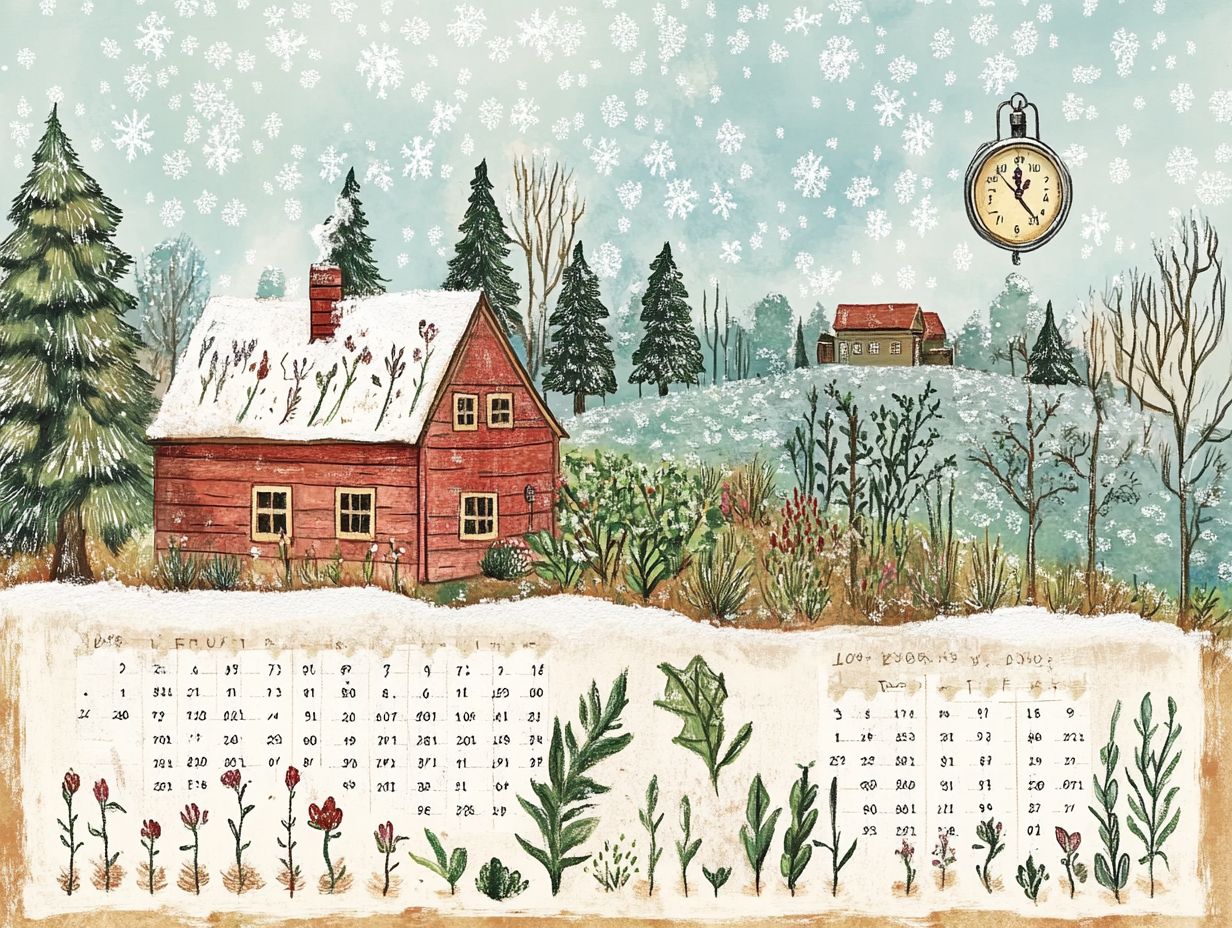
Climate, elevation, and geography are closely related. They greatly influence frost dates and determine the best time to start outdoor planting.
Tropical regions are usually warm and humid. This means fewer frost days, leading to longer growing seasons and diverse plant options year-round.
In a temperate climate, distinct seasons create a well-defined growing period. There s a greater chance of frost during early spring and late fall.
Elevation is another key factor. In mountainous areas, frost can linger into late spring. Therefore, it’s essential to choose plants that can survive frost and time your planting precisely.
Coastal regions enjoy milder temperatures due to the ocean’s moderating influence. Meanwhile, inland areas may face more severe frost.
In these situations, take protective measures. Use row covers during vulnerable periods to shield your young plants.
How to Determine Your Frost Dates
Determining your local frost dates is crucial for a thriving garden. You can achieve this through various methods.
Utilize gardening resources like interactive maps and expert insights from seasoned professionals.
Understanding the specific frost dates for your area allows you to protect your plants effectively. This knowledge helps optimize your vegetable planting schedule for a bountiful harvest.
Methods for Finding Your Local Frost Dates
To discover your local frost dates, you have a wealth of resources at your fingertips. These include historical climate records, weather forecasts, and advice from expert gardeners.
Diving into historical climate data helps you identify when the last frost typically graces your region. This insight is invaluable for optimal planting times.
Short-term weather forecasts are your allies. They enable timely decisions about covering your plants or postponing planting based on anticipated temperatures.
Local gardening experts can provide you with personalized advice that considers your area’s specific climate. Additionally, familiarize yourself with region-specific resources for accurate frost date estimates. This will significantly enhance your ability to cultivate a flourishing garden.
Preparing for Frost
Preparing for frost is essential for you as a gardener. This proactive approach safeguards your crops and promotes the longevity of your garden.
Stay updated on weather forecasts to protect your plants from unexpected frosts. Implement protective measures and follow gardening tips tailored to cool-season vegetables and tender plants.
Protecting Plants and Crops
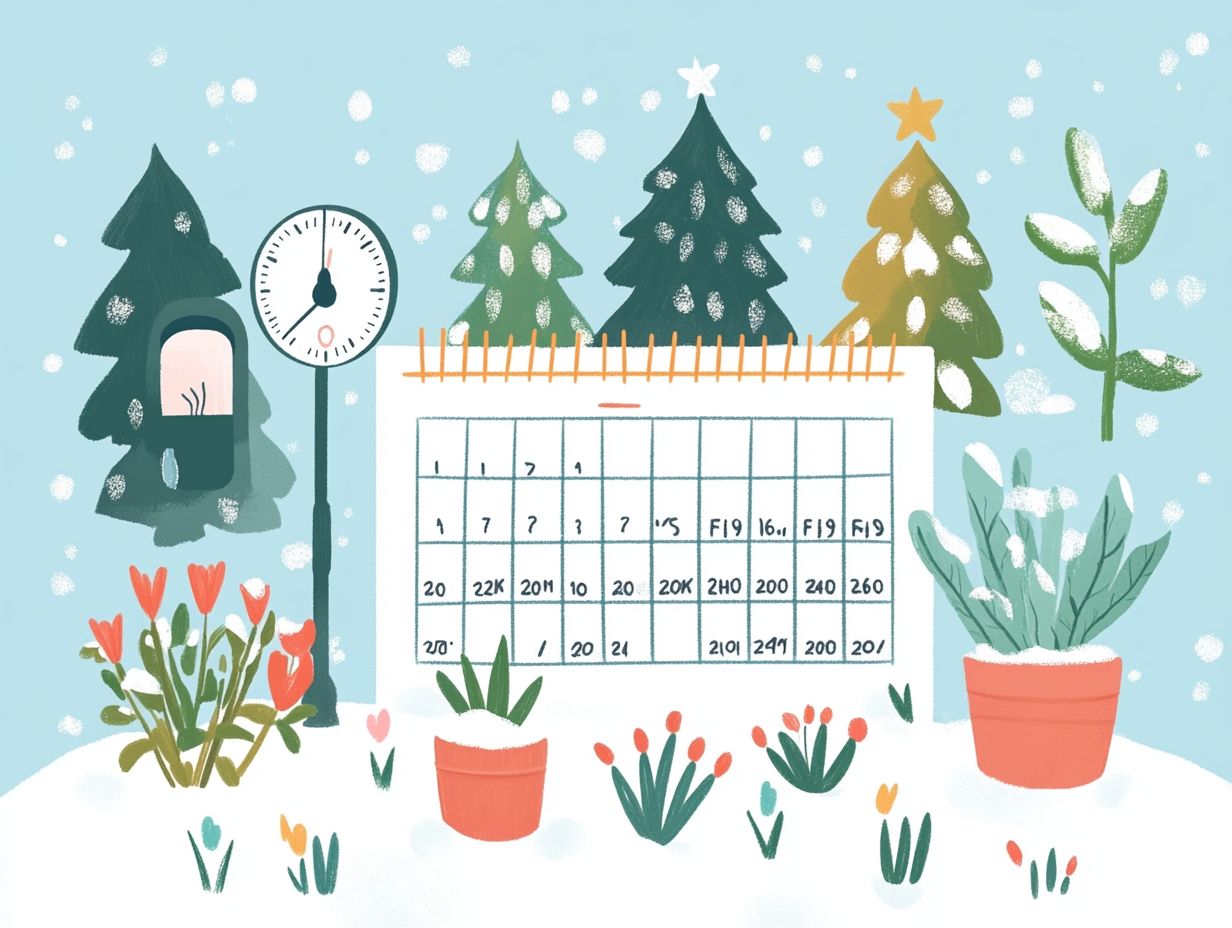
Protecting your plants from frost damage is essential for a thriving garden! Don t let frost ruin your hard work, especially for frost-sensitive varieties that can face irreversible harm from freezing temperatures.
To ensure the wellbeing of these delicate specimens, employ various effective protective measures. One straightforward approach is to use frost blankets, which trap heat and shield your plants from harsh elements.
Row covers can also provide extra insulation while allowing sunlight to filter through, creating a nurturing microclimate for growth.
Adding mulch around the base of your plants is another smart strategy. It helps keep the soil warm and minimizes rapid temperature fluctuations.
Stay vigilant and keep an eye on weather forecasts for sudden cold snaps. This will enable you to implement protective techniques promptly, ensuring optimal protection for your garden.
Other Preparations for Cold Weather
Plus safeguarding your plants, preparing for cold weather means adjusting your gardening practices to minimize frost’s effects. This ensures your outdoor planting and harvest activities continue successfully.
Start by checking your soil pH levels. They play a crucial role in nutrient availability and overall plant health. Based on your test results, you might need to add lime or sulfur for optimal growth.
Clearing your garden of debris and old crops not only helps prevent disease but also sets the stage for a tidy winter landscape.
Planning for the fall harvest is essential! Selecting crops with cold-resistant traits, which are traits that help plants survive cold temperatures, will help secure a yield even as temperatures dip.
Consider using row covers or cold frames, which are small structures that protect plants from cold weather, to provide extra warmth and protection. This can extend your growing season and foster resilience against harsh weather.
Try these strategies to create a flourishing garden, no matter how cold it gets!
Extending the Growing Season
Extending the growing season is a goal that many gardeners aspire to. There are several simple methods to help achieve this while deftly managing frost dates and seasonal challenges.
By selecting frost-resistant plants, utilizing cold frames, or employing various protective strategies, you can elevate your gardening experience and enjoy a productive yield that stretches beyond the conventional growing limits.
Tips and Techniques for Prolonging Your Growing Season
- Consider using cloches or row covers. These tools offer essential frost protection for your sensitive vegetable crops.
- Adjusting your planting times can significantly boost your crop yields. Starting seeds indoors or using heat mats to provide warmth gives your plants a head start.
- Selecting varieties renowned for their cold tolerance, like kale or specific types of carrots, can also make a remarkable difference.
- Incorporating mulching techniques helps regulate soil temperature and moisture, fostering an ideal environment for plant growth.
By weaving these strategies into your gardening routine, you can effectively shield your crops from unexpected frosts while maximizing their productive potential.
Watch this video for practical tips on protecting your garden during frost.
Frequently Asked Questions

What are frost dates and why are they important?
Frost dates refer to the average date of the last spring frost and the first fall frost in a specific area. They are important for gardeners and farmers as they help determine when to plant and harvest crops.
How do I find out the frost dates in my area?
You can find out the frost dates in your area by checking with your local garden center, agricultural extension office, or by searching online for your city or region’s frost date chart.
Why do frost dates vary from year to year?
Frost dates can vary from year to year due to changes in weather patterns. They are simply an average estimation and should be used as a guideline rather than an exact date.
What happens if I plant too early or too late based on the frost dates?
If you plant too early, your plants may be damaged or killed by a late frost. If you plant too late, your plants may not have enough time to mature before the first fall frost, resulting in a smaller harvest.
Can I extend my growing season beyond the frost dates?
Yes, you can extend your growing season by using protective measures such as row covers, cold frames, or greenhouses. These structures can help protect your plants from frost and allow you to continue growing even after the first fall frost.
Do frost dates apply to all types of plants?
Frost dates primarily apply to annual plants, which need to be planted and harvested within a specific growing season. Perennial plants may not be as affected by frost dates as they can survive through multiple growing seasons.



